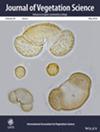Synopsis of Nardus Grassland Resurveys Across Germany: Is Eutrophication Driven by a Recovery of Soil pH After Acidification?
Abstract
Questions
How have Nardus grasslands (i.e., unfertilised grassland on acid soils) in Germany changed in recent decades? What are the ecological drivers of these changes? Were the changes in species composition caused by the decrease in atmospheric deposition of nitrogen (N) and sulphur (S) and mediated by the recovery of soil pH? Have climate change and changes in management contributed to changes in species composition?
Location
Six regions within the German low mountain range and the northern Alps (230 m—2120 m a.s.l.).
Methods
For a synoptic analysis of vegetation change, we compiled vegetation and soil data (pH, C:N ratio) of 375 quasi-permanent plots in Nardus grassland sampled between 1971–1989 and 2012–2021. We analysed changes in different species groups, mean ecological indicator values and soil parameters and tested for effects of time and elevation with mixed effect models. Path analyses and redundancy analysis were used to identify the drivers of vegetation change, including data on N and S deposition, annual temperature, annual precipitation and management.
Results
Soil pH increased and C:N ratio decreased across study regions in Germany. We also found overall increases in mean Ellenberg indicator values for N and soil reaction. Species of nutrient-rich grasslands increased, as did total species richness. In contrast, character species of Nardus grassland and dwarf shrubs decreased. However, these patterns were less pronounced at high elevations. Declining total N and S deposition was associated with higher pH values and lower C:N ratios, which had positive effects on nutrient-demanding grassland species and negative effects on cover of Nardus grassland character species and on dwarf shrubs. We also found indications for effects of climate warming, for example, increased mean Ellenberg indicator values for temperature and a negative effect on character species. Management compared with abandonment had negative effects on woody species, including dwarf shrubs and favoured low-growing herbaceous species. In addition, management effects contributed indirectly to eutrophication.
Conclusion
Nardus grasslands across Germany are affected by a decline in floristic quality associated with eutrophication (e.g., increase in nutrient indicators and decline in characteristic species). Our results suggest that after a period of airborne acidification in the 20th century, the recovery of soil pH following the reduction of acidifying S and N deposition in recent decades has been a major driver of eutrophication because of improved conditions for mineralisation and nutrient release from accumulated and ongoing N deposition. An adapted management focusing on more efficient nutrient removal will be required.


 求助内容:
求助内容: 应助结果提醒方式:
应助结果提醒方式:


